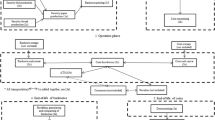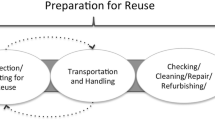Abstract
Purpose
Consumers in the Netherlands made more than 3.2 billion debit card transactions at points-of-sale in 2015, corresponding to over half of all point-of-sale payments in that year. This study provides insights into the environmental impact of debit card transactions based on a life cycle assessment (LCA). In addition, it identifies several areas within the debit card payment chain where the environmental impact can be reduced.
Methods
The debit card payment system can be divided into three subsystems: debit cards, payment terminals, and data centers used for transaction processing. Input data for all elements within each subsystem (manufacturing, transport, energy use, and disposal) were retrieved from interviews and literature study. Seven key companies and authorities within the debit card system such as the Dutch Payments Association, two banks, two data centers, one payment terminal producer and a recycling company contributed data. The analysis is conducted using SimaPro, the Ecoinvent 3.0 database and the ReCiPe endpoint (H) impact assessment method.
Results and discussion
One Dutch debit card transaction in 2015 is estimated to have an absolute environmental impact of 470 μPt. Within the process chain of a debit card transaction, the relative environmental impact of payment terminals is dominant, contributing 75% of the total impact. Terminal materials (37%) and terminal energy use (27%) are the largest contributors to this share, while the remaining impact comprises data center (11%) and debit card (15%) subsystems. For data centers, this impact mainly stems from their energy use. Finally, scenario analyses show that a significant decrease (44%) in the environmental impact of the entire debit card payment system could be achieved by stimulating the use of renewable energy in payment terminals and data centers, reducing the standby time of payment terminals and increasing the lifetimes of debit cards.
Conclusions
For the first time, the environmental consequences of electronic card payment systems are evaluated. The total environmental impact of debit card transactions in the Netherlands is relatively modest compared to the impact of cash payments, which are the closest substitute of debit card payments at the point-of-sale. Scenario analysis indicates that the environmental impact can be reduced by 44%.








Similar content being viewed by others
Change history
08 September 2023
A Correction to this paper has been published: https://doi.org/10.1007/s11367-023-02227-0
Notes
In SimaPro, the following databases were used: Ecoinvent 3.0, CE Generic data, USA Input Output Database, and Industry data 2.0.
According to Endres and Siebert-Raths (2009), both the electronic and gas incineration of PVC amount 19 MJ/kg. According to the CE Delft, the efficiency of electronic incineration amounts 17% and of gas incineration 19%. As each debit card contains 0.0044 kg on PVC, the energy generated through electronic incineration amounts 0.014 MJ and through gas incineration 0.016 MJ.
According to Endres and Siebert-Raths (2009), both the electronic and gas incineration of the polycarbonate casing of a terminal amounts 30 MJ/kg. According to the CE Delft, the efficiency of electronic incineration amounts 17% and of gas incineration 19%. As a terminal contains 0.152 kg on polycarbonate, the energy generated through electronic incineration amounts 0.775 MJ and through gas incineration 0.866 MJ, leading to a total energy recovery of 1.641 MJ.
As the total environmental impact of the Dutch economy is unknown, but its GWP is known, the GWP of the debit card system is compared with the GWP of the Dutch economy.
The economic importance of the of debit card payments in 2015 was proxied by their resource costs to society. Resource costs for debit card payments refer to the costs to society (i.e. banks, retailers, data centers, and clearing houses) reflecting the use of resources in the production of debit card payments. Cost figures for the year 2009 (Jonker 2013) have been extrapolated taking into account the share of the costs which vary with debit card usage, the growth in debit card usage between 2009 and 2015, and the development of the prices in the services sector.
References
Afman MR, Wielders LML (2014) Achtergrondgegevens stroometikettering 2013. Publicatienummer: 13.3C86.16 (in Dutch). CE Delft, Delft
Bank of England (2013) LCA of paper and polymer banknotes. The final report. Retrieved at 19th April 2017 from http://www.bankofengland.co.uk/banknotes/polymer/Documents/lcapaperandpolymerbanknotes
Bolt W, Jonker N, Plooij M (2016) European payment systems: pricing, regulation and innovation. In: Beck T, Casu B (eds) The Palgrave handbook of European banking. Palgrave Macmillan
Brander M, Hutchison C, Sherrington C, Ballinger A, Beswick C, Baddeley A, Black M, Woods J, Murphy R (2009) Methodology and evidence base on the indirect greenhouse gas effects of using wastes, residues, and by-products for biofuels and bioenergy. Report PR-091007-A to the UK Renewable Fuels Agency and the Department for Energy and Climate Change. British Standards Institute, London
CBS (2016a) Greenhouse gas emissions 5 percent higher in 2015. Retrieved at July 14th 2017 from https://www.cbs.nl/en-gb/news/2016/36/greenhouse-gas-emissions-5-percent-higher-in-2015
CBS (2016b) Opbouw binnenlands product (bbp); nationale rekeningen, (Composition gross domestic product (GDP); annual accounts). Retrieved at July 18th, 2017 from http://statline.cbs.nl/statweb/publication/?dm=slnl&pa=82262ned&d1=0-4,9-17,20-21,88,91,94,97,130-132,135-136,139,142&d2=(l-10)-l&hdr=g1&stb=t&vw=t
Dicou D, van Ewijk S, Kakes J, Regelink M, Schotten G (2016) Tijd voor transitie. Een verkenning van de overgang naar een klimaatneutrale economie. DNB Occasional study 14(2). Retrieved at April 19th 2017 from http://www.dnb.nl/binaries/1600019_WEB_tcm46-337345.pdf (in Dutch)
DNB/DPA (2016) Factsheet point of sale payments 2015, Retrieved at July 10th 2017 from http://www.dnb.nl/en/binaries/Factsheet_betalingsverkeer_uk_tcm47-341312.pdf?2017071016
DNB (2017) Payment statistics, Table 5.12 Retail payments. Retrieved at July 10th 2017 from http://www.dnb.nl/en/binaries/t5.12ek_tcm47-330678.xls?2017071014
Ebner C (2008) Smart card production environment. In: Smart cards, tokens, security and applications. Springer, Boston, MA
Endres H, Siebert-Raths A (2009) Technische Biopolymere Rahmenbedingungen, Marktsitutation, Herstellung, Aufbau und Eigenschaften. Hanser, Munich
European Central Bank (2005) LCA of euro banknotes 2003: final report. Confidential report by E2 Management Consulting AG, in cooperation with PRé Consultants. ECB, Frankfurt am Main
Fakhredin F, Bakker CA, Huisman J, Geraedts JMP (2013) Five perspectives on design for end of life: highlights of a literature review. In: Proceedings of the EcoDesign 2013 international symposium. s.n. (ed) s.l.: KITECH Korea National Cleaner Production Center (KNCPC), p 1–8
Franquesa D, Navarro L, Laopez D, Bustamante X, Lamora S (2015) Breaking barriers on reuse of digital devices ensuring final recycling. Proceedings of EnviroInfo and ICT for Sustainability 2015. https://doi.org/10.2991/ict4s-env-15.2015.32
Fukushima Y, Hirao M (2002) A structured framework and language for scenario-based life cycle assessment. Int J Life Cycle Assess 7(6):317–329
Geeraerts K, Illes A, Schweizer JP (2015) Illegal shipment of e-waste from the EU. Work package 4 “case studies”. Retrieved from http://www.efface.eu on May 20th, 2016
Green Grid (2012) Data centre life cycle assessment guidelines. White paper #45, v2. Retrieved from http://www.thegreengrid.org/~/media/whitepapers/wp45v2datacentrelifecycleassessmentguidelines.pdf on April 8th, 2016
Hanegraaf R (2017) Reducing the environmental impact of the Dutch physical payment system. MSc thesis (confidential). Utrecht University, Utrecht
Hayes A (2015) A cost of production model for bitcoin. Available at SSRN: https://dx.doi.org/10.2139/ssrn.2580904
Jonker N (2013) Social costs of POS payments in the Netherlands 2002–2012: efficiency gains from increased debit card usage, DNB Occasional Study 11(2). Retrieved from: https://www.dnb.nl/binaries/OS2_tcm46-288179.pdf
Klöpffer W, Sudström G, Grießhammer R (1996) The peer reviewing process—a case study. Int J Life Cycle Assess 1(2):113–115
Larcin A (2017) Life cycle assessment of the Dutch physical payment system. MSc thesis, Utrecht University
Marincovic C (2011) Life cycle assessment of Canada’s polymer bank notes and cotton-paper bank notes. Final report. Retrieved from http://www.bankofcanada.ca/wp-content/uploads/2011/06/Life-Cycle-Assessment-of-Polymer-and-Cotton-Paper-Bank-Noes_pt.pdf
Mayes DK, Markantonakis K (2008) Smart cards, tokens, security and applications. Springer, New York
MOB (2016) Rapportage 2015. Retrieved from http://www.dnb.nl/binaries/MOB%20Rapportage%202015,%20definitief%20-%20webversie_tcm46-342035.PDF?2016090108 (in Dutch)
O’Dwyer KJ, Malone D (2013) Bitcoin mining and its energy footprint. In: Irish signals & systems conference 2014 and 2014 China-Ireland international conference on information and communications technologies (ISSC 2014/CIICT 2014). 25th IET. IET, pp 280–285
Oliveira FB (2012) Life cycle assessment of a high-density datacentre cooling system: TeliaSonera’s green room concept. KTH, Stockholm
Polizzi Di Sorrentino E, Woelbert E, Sala S (2016) Consumers and their behavior: state of the art in behavioral science supporting use phase modeling in LCA and ecodesign. Int J Life Cycle Assess 21(2):237–251
Pre Consultants (2015) SimaPro 8.0.5 LCA software. Amersfoort
Rankl W, Effing W (2010) Smart card handbook, 4th edn. Wiley, Chichester
SER (2013) Energieakkoord voor duurzame groei. Retrieved from http://www.energieakkoordser.nl on June 2nd, 2016
Thuiswinkel (2016) “Nederlanders shoppen in 2015 voor € 16,07 miljard online”, Press release, Retrieved at July 10th 2017 from https://www.thuiswinkel.org/nieuws/3040/nederlanders-shoppen-in-2015-voor-16-07-miljard-online (in Dutch)
Wang R, Zheng S, Zheng Y (2011) Elementary mechanical properties of composite materials. In: Composites Science and Engineering. Polymer Matrix Composites and Technology. Woodhead Publishing, Sawston, pp 1–25, 547–548
Wettstein F, Lieb H (2000) Life cycle assessment (LCA) of Swiss banknotes. Swiss National Bank. Final report (online). Retrieved from https://www.snb.ch/en/mmr/reference/life_cycle_banknotes/source/life_cycle_banknotes.en.pdf. Accessed 7 Nov 2017
Whitehead B, Tozer R, Shah A, Kosik B, Maidment G, Andrews D, Dunn A (2012) The environmental burden of data centres—a screening LCA methodology. CIBSE ASHRAE Technical Symposium, Imperial College, London
Whitehead B, Andrews D, Shah A (2015) The life cycle assessment of a UK data centre. Int J Life Cycle Assess 20(3):332–349
Williams E, Kahhat R, Bengtsson M, Hayashi S, Hotta Y, Totoki Y (2013) Linking informal and formal electronics recycling via an Interface organization. Challenges 4(2):136–153
Zink T, Maker F, Geyer R, Amirtharajah R, Akella V (2014) Comparative life cycle assessment of smartphone reuse: repurposing vs. refurbishment. Int J Life Cycle Assess 19(5):1099–1109
Acknowledgements
We thank Hans Brits, Jan Dekker, Kenneth Rijsdijk, and two anonymous referees for their valuable comments and Gareth Budden for linguistic services. The views expressed in this paper are our own and do not necessarily reflect those of the CE Delft, De Nederlandsche Bank, or the European System of Central Banks.
Author information
Authors and Affiliations
Corresponding author
Additional information
Responsible editor: Zbigniew Stanislaw Klos
Electronic supplementary material
ESM 1
(DOCX 18 kb)
Rights and permissions
About this article
Cite this article
Lindgreen, E.R., van Schendel, M., Jonker, N. et al. Evaluating the environmental impact of debit card payments. Int J Life Cycle Assess 23, 1847–1861 (2018). https://doi.org/10.1007/s11367-017-1408-6
Received:
Accepted:
Published:
Issue Date:
DOI: https://doi.org/10.1007/s11367-017-1408-6




